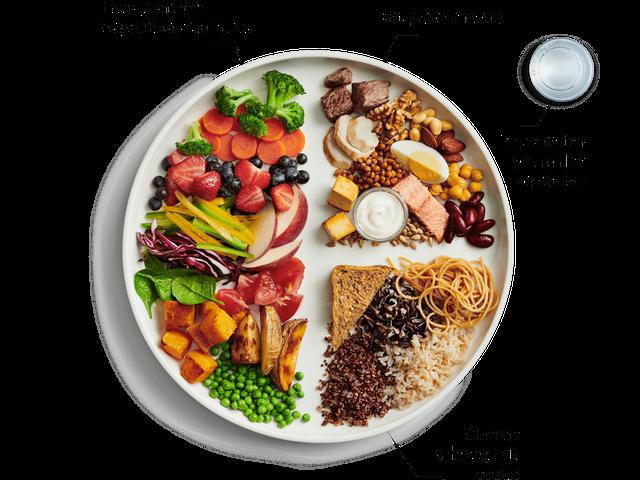Ottawa Chiropractor Health and Wellness Blog

What’s up with Canada’s Food Guide
BIG THINGS have been happening with Canada’s food guide this past week. For the first time in over 10 years Canada’s food guide has made some changes to their recommendations of what Canadians should be eating in a day. As a Naturopathic Doctor I am thrilled to see these changes and truly believe that they reflect a truly nourishing and holistic way of eating.
Breaking down the changes
One of the first major differences in the new Canada's food guide is the classification of food groups. If you can remember the original food guide was divided into 4 different food groups: fruit and vegetables, grains, milk and alternatives and meat and alternatives. For each of these groups there was a recommendation of how many servings of food from each group should be eaten in a day. However since this food guide was created over 10 years there have been some major shifts in both research surrounding what constitutes a healthy diet and in the types of food that people are choosing to eat. This has lead to Health Canada changing the food categories into three more broad categories; fruits and vegetables, whole grains and proteins.
 Image courtesy of Health Canada
Image courtesy of Health Canada
The new Canada's food guide features a picture of a plate with three food categories on it. These categories: fruits and vegetables, whole grains and proteins are much more broad than previously. This isn’t to say that meat and dairy are no longer a part of the food guide; they are just no longer their own category. Instead dairy and meat are incorporated as part of the proteins category with other sources of protein including plant sources like beans and soy. This encourages people to choose a variety of proteins instead of just focusing on dairy and meat as the previous food guide alluded to. This new categorization takes into account the variability in each individuals diet. There is no one diet fits all. Instead it is about getting an appropriate and nourishing amount of each of the three food groups in whatever capacity that takes.
The quality of food and what people are able to eat is changing. Today food sensitivities, genetically modified ingredients and ethics can change each person’s ability to eat from these original four categories. This isn’t a bad thing. The thing with Canada’s old food guide is that it was very rigid and specific. It didn’t account for many other foods that are both nourishing and energizing for the body. The new food guide does just that.
The diversity of the new Canada's food guide also emphasizes the many DIFFERENT choices that are available in each food group. From a holistic perspective incorporating many different foods within each category ensures that each person is getting all of the different micronutrients, vitamins and minerals that they need. The thing is each type of food is unique to the vitamins and minerals that it contains and nourishes the body with. Having a variety of foods including different colour vegetables, proteins and grains ensures that the body is getting all of the micronutrients that it needs. This also prevents one from building up intolerance to a specific food. There is evidence that eating the same thing every day can contribute to the development of a temporary sensitivity to that food.
One of the other major changes with Canada's food guide is its holistic nature.
The new guide not only has food recommendations for each category, it also talks about lifestyle surrounding the culture of food as well as portion sizes and fluid intake. Things such as presenting the food categories on a plate with half the plate being fruits and vegetables, ¼ being proteins and ¼ being whole grains emphasizes what a balanced meal should look like. This makes it much easier for people to work on portioning. In addition the guide talks about sugars that are present in liquids including juice, advocating for water to be the drink of choice. This is a huge shift from the previous food guide, which emphasized choosing pure fruit juices and milk. Finally the guide truly takes a holistic approach to health and diet by talking about ways of eating including sitting down and making meals social; small things that actually work to optimize digestion. These suggestions while they might seem trivial actually put the body into a restful state, which activates the digestive system and makes it easier for our bodies to process whatever it is that we are eating. This is something that many people take for granted hardly taking the time to sit and eat as they grab protein bars on the run while trying to make it to their next meeting.
Canada’s food guide has truly taken a positive turn.
These are some INCREDIBLE changes. They reflect the way that food is diverse among individuals and there is no right way to nourish your body. The holistic nature of the guide brings to attention the way that we should be eating instead of adhering to the culture of constantly being stressed and on the go that we have fostered over the last decade. No longer is it “cool” to grab a protein bar while taking a phone call and running errands. Cool, is taking time, enjoying food, nourishing your body, laughing with friends and drinking a big glass of water. Welcome to Canada’s new food guide.
FIND US ON THE MAP
Office Hours
Adjustment times by appointment please
7:30 am - 1:00 pm
3:00 pm - 6:30 pm
7:30 am - 2:00 pm
10:00 am - 6:30 pm
7:30 am - 1:00 pm
2:00 pm - 6:30 pm
Currently Unavailable
Currently Unavailable
Currently Unavailable

